In 1997, Yamaha introduced the Neos scooter. Meanwhile, the Neos is one of the most popular scooters in many countries in Europe. The model remained relatively the same until its discontinuation in 2021. After a short break, Yamaha launched the new electric Neos Electric in 2022. The electric Neos was part of Yamaha’s new electric two-wheeler line. This marks the start of Yamaha’s future electric line-up. And in 2024 Yamaha presents the Neos Dual Battery version, for almost the same price, but with a much larger range.
So we thought this was the perfect time to test out the Yamaha Neos Dual Battery for about 4 days.
A New Definition of Urban Mobility
From an environmental perspective, it’s important to acknowledge that the essence of the Neos lies in Yamaha’s commitment to delivering a scooter that not only meets the practical needs of its users but also addresses growing concerns about ecological sustainability. With its electric drivetrain, the Neos represents a significant step towards reducing emissions and ushering in a greener future for urban mobility.
However, we didn’t hop on the Yamaha Neos for that reason. Much more interesting is what the Neos can achieve with its 2.5kW hub motor in terms of acceleration and riding experience. The electric drivetrain with the hub motor provides almost instant torque, resulting in smooth and quiet acceleration. Acceleration feels similar to the Brekr, swiftly moving from rolling to the top. However, like many electric scooters, the Neos has a gradual increase in power when standing still. Meaning you don’t get full acceleration right away when starting at a traffic light. This sometimes leads to situations where you’re not the quickest off the mark. With two modes, Eco and Standard, it would be nice if the standard mode was quicker. Or adding a custom mode, allowing the user to customize the Neos to their preferences. The Yamaha Neos is also lacking engine braking and regen. This could help with the handling and with the range of the Neos.
When you’re behind the wheel of the Neos and actively riding, its true character reveals’ itself. Agile and nimble, it’s tailor-made to navigate the maze of city streets. The Neos handles sharp corners and spirited riding with confidence and ease. This immediately highlights one of the advantages of the electric Neos: in addition to its environmental performance, the Neos also delivers a high level of fun. Whether you’re navigating city traffic or cruising through winding rural roads, the Neos inspires confidence and ease in every turn. This allows an enthusiastic rider to ride smoothly and exhilaratingly. Thanks to the wider wheels, the Neos feels positively grippy. During rural rides, the Neos’ handling was better than, for example, the Super Soco TS.
The top speed is limited to 45 km/h (28 mph), or 48 km/h (30 mph) on the dashboard. An ‘ECO’ mode further limits the top speed to 24 mph. Yes, that’s low, but more and more European cities are implementing speed limits of 20 mph. That said, Yamaha claims that the new electric scooter outperforms its predecessor with the gasoline engine, the four-stroke 50cc NEO’S 4. For example, the Neos covers 100 meters in 10.9 seconds from a standstill, compared to 12.16 seconds for the older Neos. This is partly due to the air-cooled electric motor housed in the rear wheel. According to Yamaha, this motor delivers tremendous torque of 136 Nm or 100 ft/lb at just 50 rpm. Normal power is 2.3 kW/3.1 hp at 424 rpm, with a maximum power of 2.5 kW/3.4 hp at 400 rpm. This immense torque at low rpm means that once the Neos starts rolling, it accelerates eagerly.
The Neos comes without ABS and traction control but with two modes and My Ride App connectivity. A third Custom mode would be ideal but is currently lacking. The Yamaha MyRide app offers many extras and sounds convenient, but unfortunately, I couldn’t test it. One of the downsides you come across online regarding the Neos is that the dashboard only shows the remaining battery percentage. I didn’t have much trouble with this myself, partly because of the two batteries, but also because it’s relatively easy to estimate. Especially if you reset one of the trips each time you charge. However, the Yamaha MyRide app clearly displays the remaining range, so for those who prefer it, this is certainly possible. This also seems to be the most useful feature of the app. In addition, the app also shows the inclination angle and allows you to share the route with friends. There is a small open compartment for a phone, with a 12V charger, and a USB port is available as an extra, so no worries about a dead phone.
The starting mechanism takes some getting used to. This works with a rotary knob that allows you to put the Neos in its “on” position. If you want to open the seat, you turn the knob a little further and press it in. To lock or unlock the steering lock, turn the knob to the position and press it in. Once you’re used to it, it works no differently than a standard key, except that the actual key can stay calmly in your jacket or bag.
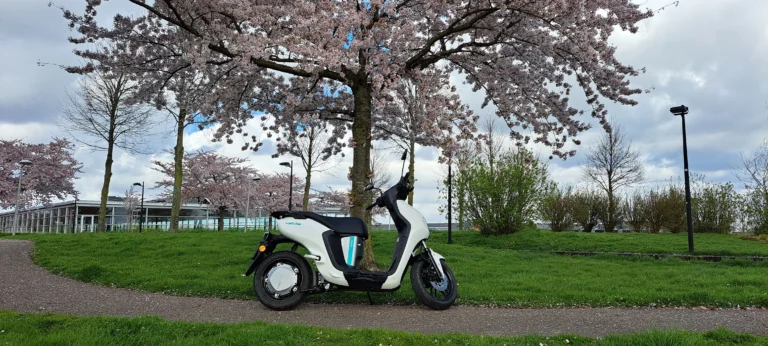
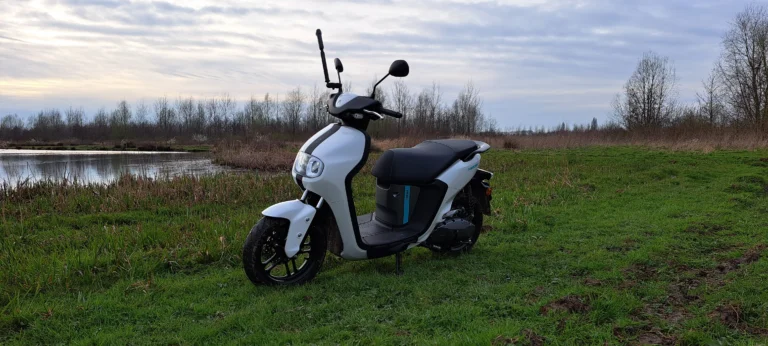
Innovation and Practical Use of the Electric Scooter
What stood out to me during the brief overview of the Yamaha Neos was its battery and range. A range of 23 miles according to Yamaha for one battery sounded very limited. Fortunately, the demo model was equipped with 2 batteries, providing an estimated range of 38 to 44 miles. That sounded much better, but not everyone is willing to purchase a second battery. Further research revealed that the Yamaha Neos is now available as the Dual Battery version, with a minimal price increase. With this move, Yamaha positions the Neos squarely in the current electric scooter market. The scooter’s dual lithium-ion battery pack offers sufficient range for most urban rides, with the added convenience of easy charging at home, work, or public charging stations.
But how did the Yamaha Neos perform on the road? Thanks to fun-rides through Rotterdam and to the Hoeksche Waard, I managed to deplete the batteries quite a bit. When battery 1 is nearly empty, the Neos enters “turtle mode,” slowing down acceleration and eventually reducing the top speed. However, once you come to a stop, at a traffic light or safely on the side of the road, it switches to the second battery, allowing you to resume normal operation. It would be nice if the batteries were connected in parallel, allowing for seamless switching while riding. This is a minor inconvenience, but not a deal-breaker.
During my daily commute between Rotterdam and Dordrecht, and Rotterdam and Rijswijk, the Neos impressed me even more. I could make the round trip between Rotterdam and Dordrecht without needing to charge at work with the Dual battery pack. However, on the way to Rijswijk, I did need to charge at work to ensure I could make it back home. This amounted to slightly more than 18 miles, realistically just under 50% of the batteries’ capacity. It’s worth noting that when both batteries are nearly empty, you can only travel the last few kilometers in “turtle mode,” but this applies to all electric scooters. An average range of 31 to 36 miles without “turtle mode” is not only acceptable but also realistic. The exact distance the “turtle mode” can take you is uncertain, but with 2x 15% battery remaining, it should come close to the 44 mile range Yamaha mentions.
The batteries themselves are stored under the seat. Unlike most other e-scooters, they do not connect to the scooter with a wired plug but instead plug in automatically at the bottom. It’s a super simple and practical foolproof system that’s primarily user-friendly. However, Yamaha takes extra precautions by adding a nice clamp at the top to secure the batteries. Naturally, the last thing you want is for the battery to come loose after hitting a bump too hard, potentially causing unwanted situations. This clamp has a trick to open it, but you quickly get the hang of it and can open it with one hand. Everything about the batteries seems focused on ease of use.
Now, perhaps a larger drawback for those who want to use the Neos daily is the charging time. Yamaha claims it takes 4 hours to charge from 20% to 80%, which seems achievable even in slightly less time. This is comparable to other brands on the Dutch market but with a shorter range. For the 0% to 100% charge, Yamaha estimates 8 hours, which seems significantly longer than the market average. Even charging the RGNT, an electric motorcycle, takes less time. The battery can be charged while it’s still in the Neos, for example, at work. Yamaha has placed a rubber seal on the edge of the helmet compartment that can be easily removed, allowing you to pass the charger cable through while still closing the seat. The batteries are easy to remove and at 8kg, not heavy at all. So, when you get home, take out the batteries and bring them inside. Charge them indoors, and while cooking and eating, the battery will be charged slowly. Before going to bed, remove the first battery from the charger, and charge the second battery in the evening. The charger is quiet and doesn’t have too many LEDs, which is nice. It was also noticeable during charging that this is the coolest charger of all the electric scooters I’ve tested so far. A cooler charger is safer, perhaps a positive aspect of the slower charging process.
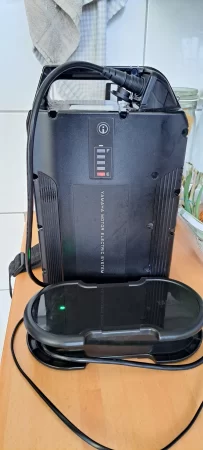


A Stylish Scooter for Everyday Use
The design of the Neos is striking. Despite Yamaha sticking to the traditional Neos scooter style, they have infused it with a modern aesthetic. With sleek lines and subtle curves exuding a sense of refinement, along with a completely redesigned headlight. The headlight may be a matter of personal taste, but I’m a fan. It emits a beautiful light pattern while riding, adding a touch of tasteful modernism to the Neos. However, it’s not just about looks; the design is also functional, with aerodynamic elements enhancing stability and efficiency. The Neos offers ample storage space, including a spacious compartment under the seat for storing a helmet and other essentials. For riders relying on their scooter for daily commuting, this added convenience is a welcome bonus. However, the amount of space under the seat depends on the number of batteries. If you use the Neos with 1 battery, practically all helmets fit under the seat. With both batteries, it may be too small for many helmets, especially if the charger needs to fit as well. However, groceries, a laptop, and a backpack with work clothes and lunch can still fit. With 2 batteries installed, there is still 37 liters of storage available.
The flat footboards and the space between the handlebar column and seat make mounting and dismounting very easy. The same footboards are also useful for carrying items (they are spacious enough for six 2-liter water bottles or a 25L bag of cat litter). There is also the option to hang a bag on the foldable hook to prevent it from sliding during turns. Further dedication to user experience is evident in the design of the Neos. From the control options to the comfortable seating position: most details seem designed to enhance the rider’s enjoyment. Novice riders will appreciate the ease of use of the Neos, while experienced riders will fully enjoy its performance and dynamic handling. The Keyless ignition makes mounting and riding off easy.
This comfortable ride is also made possible by the KYB suspension, which is excellent for the Neos. It offers controlled suspension, allowing you to throw the Neos around wherever you want, including larger speed bumps and curbs. The Neos comes standard with Maxxis tires. Although I initially had some doubts about this rubber, the Maxxis tires perform equally well on dry and wet roads. The 13-inch tires felt smooth on cobblestones and uneven road surfaces, and it was easy to navigate over speed bumps.
The rear wheel is in a class of its own. Here, Yamaha’s knowledge and craftsmanship shine through again. Firstly, the hub motor is housed in a stylish-looking rear hub. With single-sided rear suspension and no ugly box profile holding it together, this means the wheel can be easily removed for tire changes, etc. On the other side of the scooter, the wheel is attached to what appears to be a conventional scooter drive, a nice touch that makes the scooter look like the premium product it is. This dummy drive acts as a swingarm and also contains the controller for the hub motor. The tire and the outer part of the wheel are bolted to the hub motor. Thanks to the single-sided rear suspension, the right side is completely free. This makes it easy to remove the wheel from the hub motor. A significant advantage of this is that you don’t have to remove the hub motor from under the scooter for every tire change. User-friendliness and time savings, this design has been well thought out. Both the home mechanic and the dealer technician can easily replace the tires.
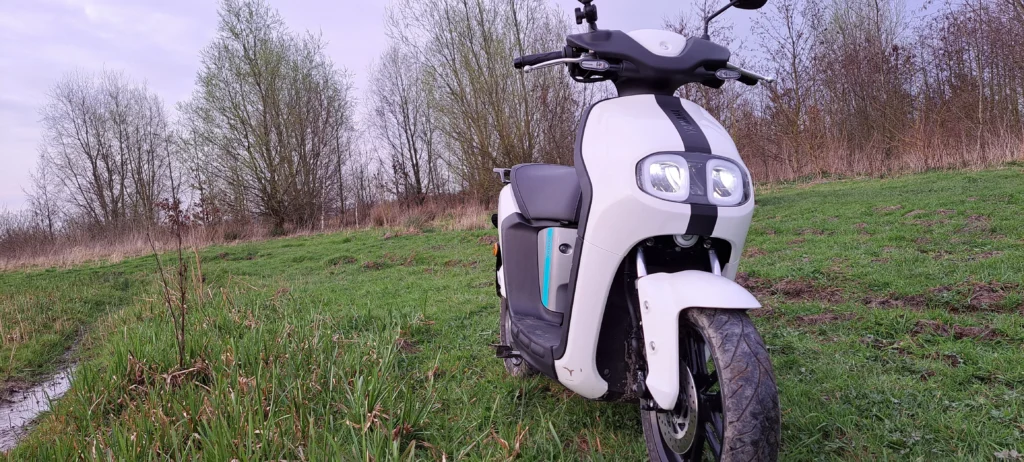

Price-wise on the Scooter Market
In the realm of urban mobility, affordability is often a key consideration for consumers. The Neos performs well in this regard too. With its competitive price and low maintenance costs, it offers excellent value for money. Naturally, when factoring in the costs of gasoline and road tax, an electric scooter quickly becomes cheaper. But how does the Neos fare against comparable e-scooters? All prices are accurate at the time of writing, but variations may occur.
The Yamaha Neos Dual Battery is priced at £3,100 at the time of writing.
With 1 battery, the Brekr B4000 (range 50-60 km, comparable) costs £3,612.
A Vmoto Soco TSx (formerly the SuperSoco TS) with a range of 35-45 km is priced at £3,399.
And the Niu NQi Sport with a range of 45-50 km is priced at £2,699.
With a range of 80 km, the Vespa Elettrica 45 is the most expensive in this lineup, priced at £6350.
Because scooters/mopeds are not as big in America most models are not available there.
It’s worth noting that the Yamaha falls within the mid-range price bracket despite being a prominent name in the lineup. Additionally, the Neos Dual Pack offers a range above the average. This positions the Neos favorably in terms of price-to-quality ratio. Maintenance and dealerships are well distributed across Europe, which is a valuable addition.
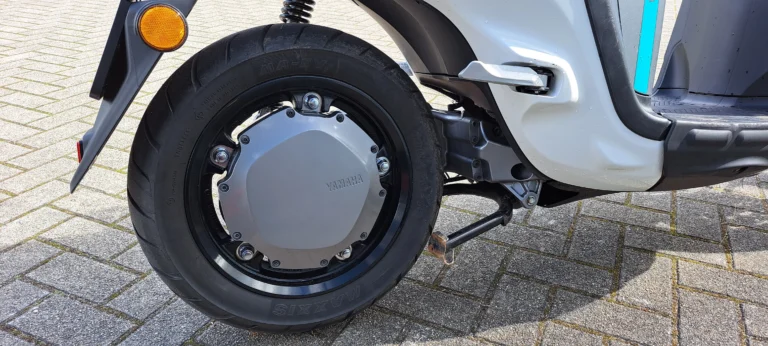
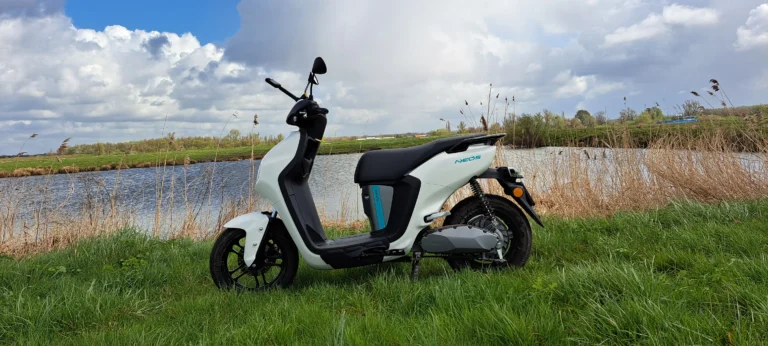
Conclusion
With the Neos, Yamaha enters a new era of electric models, and they make an impressive start. The Dual Battery version is a significant step forward, positioning the Neos as a potential market leader. It’s a high-quality 50cc-equivalent scooter that’s difficult to criticize. The build quality is typical Yamaha, with no rattling or visible flaws. The hub motor is remarkably quiet, and its mounting is surprisingly ingenious. The Yamaha Neos rides smoothly and forgivingly, making it ideal for novice riders. However, there’s enough room for experienced riders to have fun with the Neos. It could use a bit of regen/engine braking, and the handling is smooth. The improved range is excellent and more than sufficient for regular use. However, the 8-hour charging time for 0 to 100% is a downside for me and could be a reason to opt for another electric scooter.
Type of engine | Excitation 3 phase synchronized motor, hub-mounted motor |
Maximum Power | 2.3Kw / 3.1hp @ 424rpm (Rated) |
Max engine torque | 100 ft-lb / 136 Nm @ 50 rpm |
Range | Yamaha: 1st and 2nd battery; 68 km |
Top Speed | 45 km/h according to Yamaha. 48 km/h on the dash. |
Battery | Removable Lithium-ion, 2 pieces |
Battery Voltage | 50,4 V; 19,2 Ah (5 h) |
Energy Consumption | 31 Wh/km |
Charging time (20-80%) | 4 hours |
Rider aids | 2 rider modes (STD and ECO) |
Warranty | Unlimited miles/2 years. Battery 4 years |
Frame | Underbone |
Front suspension | Conventional KYB telescopic forks with 90mm travel |
Rear suspension | Single KYB rear shock with 80mm travel |
Front brakes | Hydraulically operated braking system, 200 mm disc brake |
Rear brake | Mechanical ascending and descending drum brake |
Front tire | 110-70-13M/C 48P Tubeless |
Rear tire | 130-70-13M/C 63P Tubeless |
Length | 1.875 mm |
Width | 695 mm |
Height | 1.120 mm |
Wheelbase | 1.305 mm |
Seat height | 795 mm |
Ground Clearance | 135 mm |
Weight | 90 kg without battery |
Weight battery | 2x 8 kg |
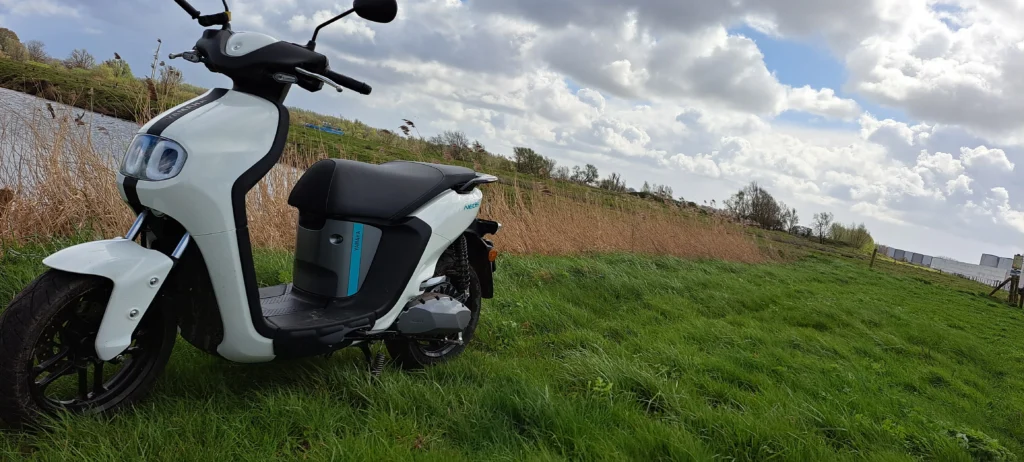
Meer Posts
Yamaha MT-09 Y AMT – 2024
RGNT No.1 Scrambler SE – 2023 (Weektest)
Brekr Model B – 2022 (Weektest)